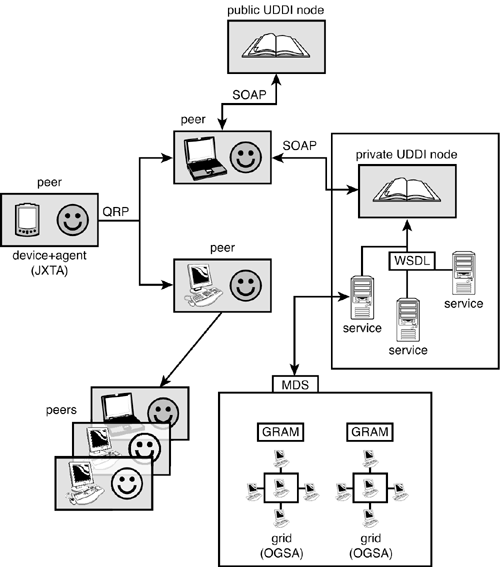The Big Picture
| It bears repeating that P2P technology does not exist in a vacuum. One of the clear trends to emerge in the last few years is that the technology world is heading toward a model where everything is a service. Computing in general has moved away from being a specialized activity that is the domain of a few experts, and requires specialized, dedicated hardware. It is being slowly transformed into a utility, much like electrical power or cable television. This evolution has spanned the whole spectrum of computing, from personal devices to personal computing to large structured enterprise computing. To enable this evolution, various technologies will need to interoperate in a seamless manner to provide a rich user experience. We can easily foresee scenarios requiring the interplay of wireless, P2P, intelligent agents, and Web services technologies, as shown in the framework in Figure 23.2. Figure 23.2. The seamless interplay of various technologies.
On the personal computing level, imagine going into an airport, to find your flight cancelled. Some current offerings will allow you to manually make new reservations using your PDA. Imagine, however, that your software agent gets notified of the cancellation and takes action. This will trigger a series of transactions and interactions involving a large number of technologies: Using JXTA Search Query Routing Protocol (QRP), your agent will look for another traveler willing to trade their seat for yours, with approval from the airline. Using SOAP to query a public UDDI registry, it will then find a travel agent to reshuffle your travel plans and rebook your itinerary. The travel agent services might in turn involve a combination of several services composed in a particular workflow. On the enterprise computing level, imagine an engineer walking to the manufacturing floor to examine a prototype that came off the line. Noticing some defect in the design, the engineer can request new computer simulations be performed by having her software agent access her company's private UDDI node and find a relevant computing service by its WSDL description. This service might be a proxy for a computing grid that conforms to OGSA, and computing resources are located through MDS, as defined by the Globus Toolkit. At the same time, the agent is querying other peer nodes for some parameters needed for the computation. Once the simulation is done, the design is updated and downloaded to the manufacturing robots. It should become clear from these scenarios that standards are an essential requirement for this kind of interoperability. As both Web services and P2P technologies mature, it is inevitable that additional standards and architectures will emerge, blurring the lines between the two types of technologies. In this manner, Web services will be able to act as peer nodes in a P2P environment, and P2P systems will be invoked as services in a Web services environment. Note Here are some additional resources for material discussed in this chapter:
|
